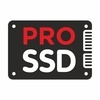SSD with DRAM and without DRAM: understanding the differences

SSD with DRAM and without DRAM: understanding the differences
Solid-state drives (SSDs) have become an integral part of modern computers, providing lightning-fast download and application speeds. However, when choosing an SSD, you will come across two main options: drives with DRAM cache and drives without DRAM but with HMB technology. In this article, we'll take an in-depth look at the differences between these two types of SSDs to help you make an informed decision.
What is DRAM Cache?
DRAM cache is a high-speed memory that is used to temporarily store frequently accessed data. When a computer accesses data stored on an SSD, it first checks the DRAM cache. If the data is in the cache, it can be retrieved much faster than if it were read directly from the flash memory.
Advantages of SSD with DRAM cache:
Faster performance: DRAM cache dramatically improves SSD performance, especially when performing tasks that require fast access to data, such as gaming, video editing, and running applications.
Reduced latency: DRAM cache helps reduce the latency that occurs when accessing data on an SSD. This means that your computer will react faster and smoother.
Increased durability: DRAM cache can help extend the lifespan of an SSD because it reduces the number of writes to flash memory.
What is HMB?
HMB (Host Memory Buffer) is a technology that allows an SSD to use a portion of a computer's random access memory (RAM) as a cache. Unlike DRAM cache, HMB does not require dedicated memory on the SSD itself.
Advantages of a DRAM-free SSD with HMB:
Lower cost: SSDs without DRAM are usually less expensive than SSDs with DRAM cache because they don't require additional memory.
Increased capacity: SSDs without DRAM can have more capacity since they don't require space for a dedicated DRAM cache.
Improved power efficiency: SSDs without DRAM consume less power than SSDs with DRAM cache, which can be important for laptops and other portable devices.
How to choose between SSD with DRAM and without DRAM with HMB?
Choosing between a DRAM SSD and a non-DRAM with HMB depends on your specific needs and budget. If you want maximum performance and are willing to pay for it, then an SSD with DRAM cache is the best choice. However, if you're looking for a more affordable option with enough performance for most tasks, then a DRAM-free SSD with HMB can be a great option.
Here are a few key points to consider:
Usage: For gaming, video editing, and other tasks that require high performance, an SSD with DRAM cache is the best choice.
Budget: A non-DRAM SSD with an HMB is usually cheaper than an SSD with a DRAM cache.
Capacity: SSDs without DRAM can have more capacity since they don't require space for a dedicated DRAM cache.
Power consumption: SSDs without DRAM consume less power, which can be important for laptops and other portable devices.
Conclusion
Choosing between an SSD with DRAM cache and a non-DRAM SSD with HMB is a matter of trade-off between performance, cost, capacity, and power consumption. Understanding the differences between these two types of SSDs will allow you to make an informed decision that best suits your needs and budget.
❗️ The article was formed with the help of the ChatGPT neural network
- Arts
- Business
- Computers
- Spellen
- Health
- Home
- Kids and Teens
- Money
- News
- Recreation
- Reference
- Regional
- Science
- Shopping
- Society
- Sports
- Бизнес
- Деньги
- Дом
- Досуг
- Здоровье
- Игры
- Искусство
- Источники информации
- Компьютеры
- Наука
- Новости и СМИ
- Общество
- Покупки
- Спорт
- Страны и регионы
- World


